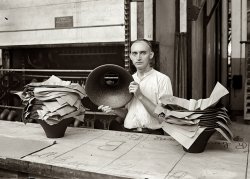
MAY CONTAIN NUTS

Search Shorpy
SHORPY ART

Framed or unframed, desk size to sofa size, printed by us in Arizona and Alabama since 2007. Explore now.
Join and Share
Ad-Free Shorpy
Shorpy is funded by you. Patreon contributors get an ad-free experience.
Learn more.

Recent comments
- And we all know
- How do you get to that Carnegie Hall joke?
- Uneeda Move
- Charlie here's your sandwich!
- 'The National Food' no more
- Urban Bonnets
- Motorcycle
- Still there
- Stormy Day on Shorpy
- Hi Octrain
- This is the colorized version.
- Thanks
- Low and Slow
- Virtually still there
- Monogram??
- Power in the Shadows
- The rest of the story?
- $0.05
- The High Road to Taos
- One-Way Streetcar Tracks
- Delivery Truck
- Holy preservation, Batman!
- The American Magazine
- About face
- Freddy N on fishing
- Lime mortar
- Background
- Serious instruction
- Chained
- Gamut of Emotions
Member Photos
The Shorpy
Print Emporium
Print Emporium
Search Shorpy
Search results -- 30 results per page
- Five-Tube Chassis: 1937
- ...
Designed for mass production Compare these to the Atwater Kents of the twenties. The A-K radios were more like an Erector set, ... and a good ground could deliever quite a shock!
Atwater-Kents And, nixiebunny, the Atwater-Kents were tuned radio frequency ... Posted by Dave - 05/05/2013 - 7:57am -
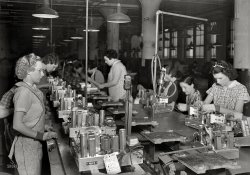
- Model 47: 1928
- Philadelphia circa 1928. "Atwater Kent Factory for T.R. Shipp." Assembling the Atwater Kent Model 47, back when radios were the iPad of their day. National ... Posted by Dave - 08/21/2012 - 7:52pm -
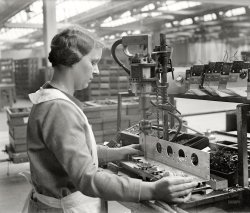
- Metropolis: 1925
- Circa 1925, another scene from the Atwater Kent radio factory in Philadelphia. National Photo Company Collection ... Posted by Dave - 08/05/2012 - 10:57am -
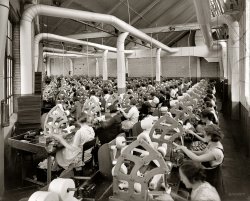
- Street Life: 1925
- ... was good for shortwave. I used to love tuning the old Atwater Kent to BBC London or the English broadcasts out of Cairo or Istanbul, ... Posted by Dave - 08/29/2012 - 8:45pm -
![Street Life: 1925 "Rowhouses and moving company." Circa 1925, the furniture and hauling business of Sam Madeoy at 600 H Street N.E. National Photo Company. View full size.
Not a dry eye in the houseEast Lynne! "Gone! And never called me mother!"
The Other Side
Just Hangin' AroundThat looks like a good place to sit and yap, hide from the wife, wait for the taverns to open, etc. You can almost hear what those rickety, wobbly cellar doors would sound like as he sat down on the edge of one. And that little fence falling apart looks like something the Little Rascals should be climbing through to go steal some apples.
Car stopI presume "car stop" is a trolley car stop? You can see the rails in the street.
1925 IndeedAll the visible posters announce shows for either Dec 13th or 14th, 1925.
William Ebs, ventriloquist opened at the Strand on Dec 13th.
The burlesque Moonlight Maids starring Anna Toebe and Billy Hagen, opened at the Mutual, Dec 13th .
East Lynne, an "old triangle theme- full of melodrama, heart interest, cross love, murder and what not" began playing the 14th.
Thurston, "magician extraordinaire" made live horses vanish at the Belasco, Dec 14th.
I'm not sure how long typical posters would have remained up in the 1920s, but since all advertise for such a narrow date range its seems safe to say that they were probably replaced often and therefore this photo is mid-December 1925
Samuel Madeoy was a Russian immigrant born circa 1880. According to the 1920 census, he lived at 600 H street with his wife Rose, three daughters and a son. In Dec 24th he remarried. In March 1925 he purchased (and moved?) properties at 12 and 14 E street Southeast.
This corner is a few blocks from where I live - its now a parking lot for a grocery store.
[Sam seems to have been a colorful character -- had a few brushes with the law running numbers and selling booze. And made the news when he spontaneously combusted one day. - Dave]
Trolley reduxI'm not sure exactly when the street car was discontinued, but ironically they are trying to get a line reestablished on H Street. Hopefully it will be faster than the X2 Metrobus, which you can usually beat walking...
Up on the roof Someone on the second floor was a radio buff, that antenna was good for shortwave. I used to love tuning the old Atwater Kent to BBC London or the English broadcasts out of Cairo or Istanbul, even the foreign language broadcasts were exotic enough to keep my brother and I listening as late as allowed. Then it was crystal radios under the blankets, tuning in to WWV, the Grand Old Opry and the Foggy Mountain Boys, yes, all the way up in Upstate NY, 1955.
(The Gallery, D.C., Natl Photo, Stores & Markets)](https://www.shorpy.com/files/images/32237u.thumbnail.jpg)
- Our New Life: 1936
- ... the sewing machine table) is from the shipping crate of an Atwater Kent console radio. Note, too, that 1936 was the year Kent closed the ... Posted by Dave - 07/12/2014 - 2:40pm -
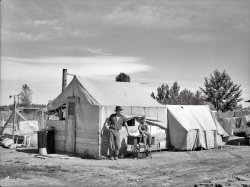
- Dept. of Life Rafts: 1912
- ... This was the Detroit Drydock factory at Orleans & Atwater in Detroit. Building still stands, albeit precariously.
(The ... Posted by Dave - 08/21/2012 - 4:50pm -
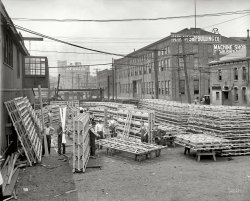
- White Dome: 1925
- ... "Golly gee, folks, It's just negative damage." Sales of Atwater Kent radios shot through the roof and area movie places were packed as ... Posted by Dave - 09/11/2011 - 6:41pm -
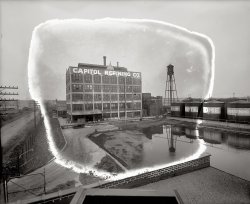
- Radio Men: 1928
- The Atwater Kent radio factory in Philadelphia in 1928 or 1929. View full size. ... Posted by Dave - 09/03/2012 - 10:44am -
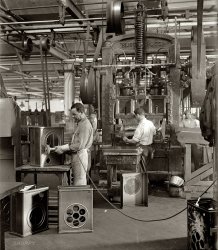
- Scavenger Truck: 1933
- ... and UNderhill.
The Mission exchange on 25th Street had ATwater, MIssion and VAlencia.
The Onondaga Street exchange near Balboa ... Posted by Dave - 12/02/2014 - 8:37pm -
![Scavenger Truck: 1933 October 1933. "Kleiber motor truck -- Bay Shore Scavenger Co." An ominous-looking conveyance made all the more foreboding by that toxic telephone exchange. 8x10 acetate negative by Christopher Helin. View full size.
Well equippedSix state-of-the-art cadaver hooks at the back of this conveyance. Ready for anything, but rarely did they need all six unless the Barbary Coast got particularly rambunctious.
One man's trash ...When I attended college in San Francisco, I learned that scavenger companies were called garbage collectors or waste management elsewhere.
HemlockI am very impressed by the sharpness of this photo.
Does anybody know the origin of the choice of Hemlock as an exchange name? If it was a locality why was it so named?
I wonder why the windscreen on this truck (that looks new) appears to be grilled. I would have thought overhead protection of the cab might have been desirable rather than grilles here.
[I suspect they are grab bars, for holding onto while riding standing up. -Dave]
Early stair stepperIt appears that the trash collector would climb up he running board and go up two more steps to load the truck. Note the cutout behind the fender and the hand holds on the windshield.
HEmlock et. al.In San Francisco there were several different Central Exchanges that each had their own set of local exchange prefixes. Many of these survive in phone numbers today if the users have had them for a long time.
My own is KLondike-2 (552), which I've had since the 1970s. Originally there were seven central exchanges but by 1958 there were these four:
In SF the downtown exchange on McCoppin Street had HEmlock, KLondike, MArket and UNderhill.
The Mission exchange on 25th Street had ATwater, MIssion and VAlencia.
The Onondaga Street exchange near Balboa Park had DElaware, JUniper and RAndolph.
And the one at 21 Folsom Street near the Embarcadero (which connected SF with Oakland and points east) had ROchester, EXbrook and WEather.
(The Gallery, Cars, Trucks, Buses, Chris Helin, San Francisco)](https://www.shorpy.com/files/images/SHORPY-154-02.thumbnail.jpg)
- Portrait of Caroline: 1939
- A closeup of Caroline Atwater, seen earlier this week, in the doorway of her kitchen in Orange ... Posted by Dave - 09/09/2011 - 11:49am -
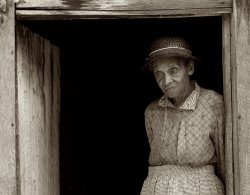
- Radio Days: 1928
- 1928. Speaker grille assembly at the Atwater Kent radio factory in Philadelphia. View full size. National Photo ... Posted by Dave - 05/02/2016 - 11:14am -
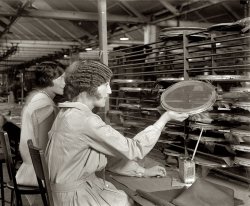
- Mr. Speaker: 1925
- Philadelphia, 1925. Atwater Kent radio factory. "Final inspection of loudspeaker after baking ... Posted by Dave - 05/02/2016 - 11:51am -
